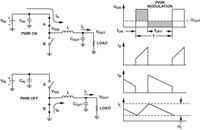themaccabee
Full Member level 4
Hi,
I want to know one thing about a buck converter in DCM mode ..may b its silly..But my question is..
When the buck converter operates in DCM mode and is in steady state..
1)will the current through the inductor rises as soon as the switch is turned ON?
2)Assume a 10V to 5V/1A buck regulator..It is in steady state with 5R load connected..
Now the load resistor is increased to high value..so current drawn is negligible..
Now as the switch turns ON inductor sees a voltage difference across it and current through it rises..Till the Ton period is over.Now as Toff begins inductor current flows through the diode..So unlike in CCM why the inductor current dies off quickly?.
May be the capacitor is not getting discharged as in the CCM case & the peak inductor current is not same as in the CCM case..
May be whole thing is silly but im quite unclear about the operation in DCM..
can some one help me ?
Thanks
I want to know one thing about a buck converter in DCM mode ..may b its silly..But my question is..
When the buck converter operates in DCM mode and is in steady state..
1)will the current through the inductor rises as soon as the switch is turned ON?
2)Assume a 10V to 5V/1A buck regulator..It is in steady state with 5R load connected..
Now the load resistor is increased to high value..so current drawn is negligible..
Now as the switch turns ON inductor sees a voltage difference across it and current through it rises..Till the Ton period is over.Now as Toff begins inductor current flows through the diode..So unlike in CCM why the inductor current dies off quickly?.
May be the capacitor is not getting discharged as in the CCM case & the peak inductor current is not same as in the CCM case..
May be whole thing is silly but im quite unclear about the operation in DCM..
can some one help me ?
Thanks
